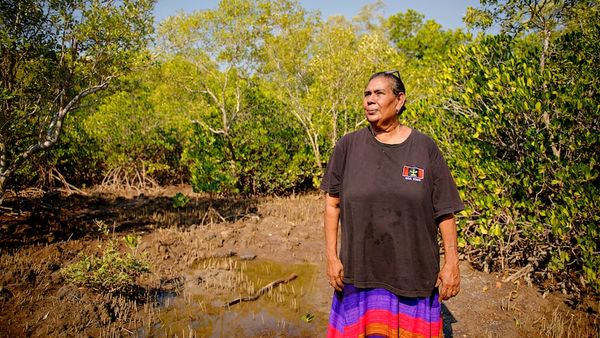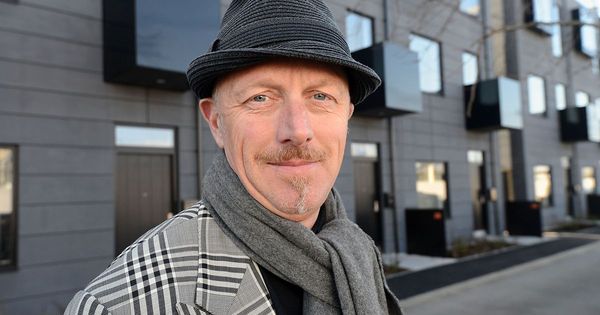Northern Territory Arts Minister Chansey Paech is calling for a national investigation into "alarming" allegations of unethical practices and interference by white assistants, that are "damaging" the Indigenous art industry.
Mr Paech has written to his South Australian counterpart, Andrea Michaels, and the federal arts minister, Tony Burke, calling for their cooperation to address the scandal engulfing the APY Art Centre Collective (APY ACC), which represents more than 500 Anangu artists over the APY Lands region of Central Australia.
Last month, footage secretly obtained by The Australian newspaper was released that appeared to show a non-Indigenous assistant making creative decisions and painting on renowned artist Yaritji Young's depiction of the Tjukurpa — the spiritual and sacred law that governs culture.
The footage was taken at the Tjala Art Centre, in South Australia's far north, which is part of the APY ACC.
Mr Paech told the ABC he was "horrified and alarmed" by the vision.
"We cannot continue to ignore the fact that these are serious allegations, which must be addressed," he said.
The footage has sparked claims that some white art centre assistants interfere in the creation of work that is then sold as authentic Indigenous artworks.
Mr Paech said there needed to be an investigation to clear people of wrongdoing, "or to look at the appropriate action if people have interfered because fake art harms culture".
In his letter to Ms Michaels, Mr Paech said the controversy was causing "reputational damage" to the "Aboriginal art movement [which] enriches our nation, culturally and economically".
"It showcases the longest-surviving culture to the rest of the world and preserves important stories and practices.
"The integrity of the works, art centres and artists is paramount."
Mr Paech told the ABC the allegations were affecting sales of Indigenous artworks, with some art centres reporting a "40 per cent" drop in sales.
"It's absolutely hitting them very hard, and also the reputation of First Nations people in the creative space," Mr Paech said.
"It is their dreaming, it is their narrative piece, and any form of disruption or interfering with that erodes a very important spiritual narrative that is expressed on that canvas."
A statement by the APY ACC — that has since been removed from its website — had "strenuously" denied "the over-arching narrative that APY ACC art and any artists are compromised".
"To the contrary. We believe our professional studios meet highest standards of integrity and professionalism," the statement had read in part.
It is unclear why the statement was removed.
'Absolutely serious'
Mr Paech said Australia's national art institutions needed to postpone exhibitions and award ceremonies involving Indigenous artists until the matter was thoroughly investigated.
"I think that all national institutions [in the Northern Territory] or in Canberra or in South Australia, need to put a hold on until an investigation is done into those allegations," he said.
"This is about also sending a reminder to institutions right across the country, don't keep the machine churning, we need to resolve the issue.
"[We need to] deal with those allegations before we can move on, because this is absolutely serious."
In the wake of the allegations, the National Gallery of Australia postponed the opening of APY ACC's Ngura Pulka exhibition, which the NGA had promoted as a "landmark exhibition of major new works".
On April 10, the NGA ordered a review into the provenance of the 28 paintings in the exhibition, and has said it will release the findings publicly when they are received later this month.
Ms Michaels said in a statement that she had been communicating with Mr Burke about options "in response to the allegations raised in consultation with the Anangu people from the APY Lands and those working through the Adelaide Studio”.
She said the allegations about authenticity and provenance were "very troubling".
"The South Australian government is committed to supporting Aboriginal artists and art centres across South Australia to share their art with the world," she said.
"The integrity of that art and respect for their culture is vital."
Mr Burke's office declined to respond to the ABC.
'Utter disbelief and disappointment'
Cecilia Alfonso, who manages the Warlukurlangu Art Centre in the Northern Territory, expressed her "utter disbelief and disappointment" that this year's National Aboriginal and Torres Strait Islander Art Awards (NATSIAA), hosted by the Museum and Art Gallery of the Northern Territory, had listed as a finalist a work by artist Yaritji Young, whose painting is at the centre of the allegations.
She was also concerned by the prestigious award's guidelines for prospective entrants.
"The museum has changed the guidelines altogether, making non-Indigenous participation and collaboration acceptable for this award, and that change in the guidelines was very surprising," she said.
"I think that this has the potential really to damage our market."
Ms Alfonso said she was surprised at the lack of debate about the changes in the industry.
"There seems to be very little action from the bodies that should be appropriately responding to the allegations that are out there.
"We have peak bodies out there, but everybody seems very muzzled and quiet."
She said that the lack of debate could change the Indigenous art industry forever.
"Is this the new norm that we want? When you buy an artwork, you can't be guaranteed that the painting is actually painted by an Indigenous person," she said.
Museum and Art Gallery NT director Adam Worrall said in a statement that while the gallery is concerned about allegations where "artists have not consented to non-Indigenous participation on their artwork," it is not an "arbitral body", but supports the artists' agency and authorship of NATSIAA entrants.
On the inclusion of a work by Yaritji Young, Mr Worrall said that the work entered into this year's NATSIAA "is not the same canvas," as documented in the video footage.
He said that "each artist from Tjala Arts has confirmed their entered artwork is a solo entry and not a collaboration".
"It is not MAGNT’s place to set the rules for how artists produce their work, though MAGNT does require that any work/s submitted is the principal artistic vision and creative output of Aboriginal and Torres Strait Islander artists," he said.
Mr Worrall said that MAGNT recognised that clarity was needed in their guidelines for artists who wanted to acknowledge their non-Indigenous collaborators on their entry forms.










